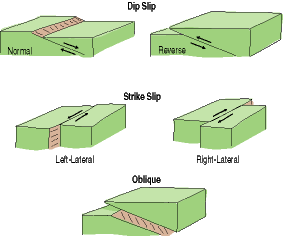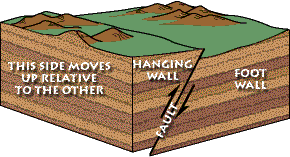If during an earthquake a hanging wall slides upward relative to a footwall the fault is termed if the fault is shallow much closer to horizontal than vetical.
Hanging wall moves upward shallow.
They are common at convergent boundaries.
In a fault the fault plane is less than 35 from horizontal and the hanging wall block moves upward relative to the footwall block.
Reverse shear stress at sufficient depth within a fault plane can induce ductile shear forming a fine grained metamorphic rock named.
Thrust faults are reverse faults that dip less than 45.
Together normal and reverse faults are called dip slip faults because the movement on them occurs along the dip direction either down or up respectively.
Hanging wall lies vertically above the footwall b.
Hanging wall and footwall.
These are often found in intensely deformed mountain belts.
The hanging wall moves up and over the footwall.
Footwall lies to the left of the hanging wall 55.
The forces creating reverse faults are compressional pushing the sides together.
The hanging wall occurs above the fault plane and the footwall occurs below it.
Boundaries of metamorphic core complexes.
Hanging wall up footwall down.
When working a tabular ore body the miner stood with the footwall under his feet and with the hanging wall above him.
With compressional forces the hanging wall moves upward relative to the footwall.
Basin and range region.
This terminology comes from mining.
The fault plane is greater than 35 from horizontal and the hanging wall block moves upward relative to the footwall block shear stress at sufficient depth within a fault plane can induce ductile shear forming a fine grained metamorphic rock named.
Thrust faults with a very low angle of dip and a very large total displacement are called overthrusts or detachments.
Footwall lies vertically above the hanging wall c.
Hanging wall down footwall up.
Reverse faults form when the hanging wall moves up.
During an earthquake if a footwall slides upward relative to a hanging wall as shown in the figure below the fault is termed a fault.
In a fault the fault plane is greater than 35 from horizontal and the hanging wall block moves upward relative to the footwall block.
Hanging wall lies to the left of the footwall d.
Zones of crustal extension.
The two sides of a non vertical fault are known as the hanging wall and footwall.























